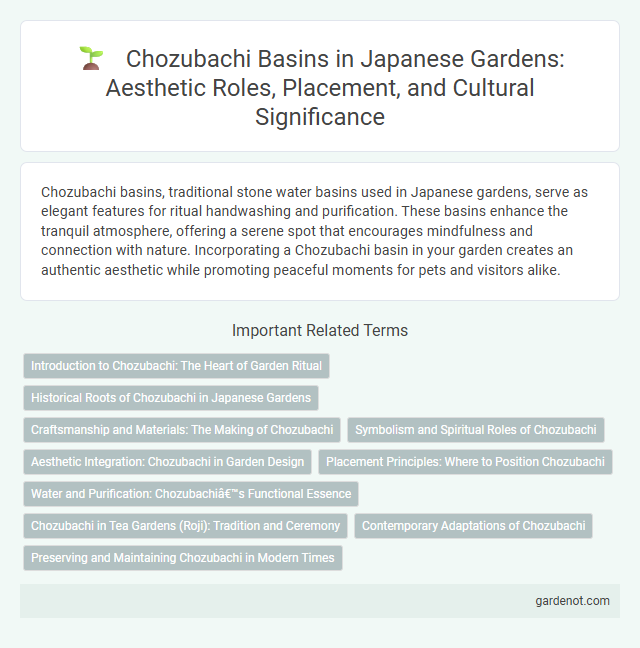Chozubachi basins, traditional stone water basins used in Japanese gardens, serve as elegant features for ritual handwashing and purification. These basins enhance the tranquil atmosphere, offering a serene spot that encourages mindfulness and connection with nature. Incorporating a Chozubachi basin in your garden creates an authentic aesthetic while promoting peaceful moments for pets and visitors alike.
Introduction to Chozubachi: The Heart of Garden Ritual
Chozubachi, a traditional Japanese stone basin, serves as the essential element for purification rituals in Japanese gardens. Positioned near garden entrances or tea houses, it allows visitors to cleanse their hands and mouths, symbolizing spiritual purification before engaging with the garden's serene environment. This water basin embodies the harmony between nature and ritual, reflecting the cultural emphasis on mindfulness and respect.
Historical Roots of Chozubachi in Japanese Gardens
Chozubachi basins have their origins in traditional Japanese temple rituals, serving as water basins for ritual purification before prayer or tea ceremonies. Historically, these basins symbolize spiritual cleansing and are crafted from natural stone, often sourced locally to blend harmoniously with garden surroundings. Their integration in Japanese gardens reflects the cultural emphasis on purity, mindfulness, and the seamless interaction between nature and human design.
Craftsmanship and Materials: The Making of Chozubachi
Chozubachi basins exemplify exceptional craftsmanship through their meticulous carving from natural stone, typically granite or volcanic tuff, chosen for durability and aesthetic texture. Artisans utilize traditional techniques such as hand chiseling and polishing, ensuring each basin's unique form complements the garden's serene atmosphere. The natural aging process of the stone enhances the basin's appearance over time, integrating seamlessly with seasonal changes in the Japanese garden.
Symbolism and Spiritual Roles of Chozubachi
The Chozubachi basin in Japanese gardens serves as a symbolic purification vessel where visitors cleanse their hands and mouths before entering sacred spaces, reflecting Shinto and Buddhist practices of ritual purification. This act of washing represents the spiritual cleansing of impurities, promoting mindfulness and respect for the garden's serene environment. The basin embodies harmony and renewal, reinforcing the garden's role as a place of contemplation and spiritual connection.
Aesthetic Integration: Chozubachi in Garden Design
Chozubachi basins exemplify seamless aesthetic integration in Japanese garden design by harmonizing water elements with natural surroundings, enhancing tranquility and visual balance. Their stone craftsmanship and placement reflect traditional wabi-sabi principles, emphasizing simplicity and the beauty of imperfection. Positioned near garden entrances or tea houses, chozubachi serve both functional ritual cleansing and as focal points that elevate the garden's contemplative atmosphere.
Placement Principles: Where to Position Chozubachi
Chozubachi basins are traditionally positioned near pathways or entrances within Japanese gardens to facilitate easy access for handwashing, symbolizing purity before entering sacred spaces. They are often placed slightly lower than eye level to allow natural water flow and encourage mindful, respectful use. Strategic placement aligns with garden elements like stones, lanterns, and water sources to maintain harmony and balance in the overall design.
Water and Purification: Chozubachi’s Functional Essence
The Chozubachi basin in Japanese gardens serves as a symbolic and functional element for water purification rituals, emphasizing the importance of cleanliness before entering sacred spaces. Typically made from stone, the basin collects pure water for ceremonial hand-washing, embodying spiritual cleansing and mindfulness. Its presence reinforces the cultural value of water as both a physical and spiritual purifier within traditional Japanese garden design.
Chozubachi in Tea Gardens (Roji): Tradition and Ceremony
Chozubachi basins in Japanese tea gardens, known as roji, serve a vital role in the tea ceremony by providing a place for guests to purify their hands and mouths before entering the teahouse, symbolizing spiritual cleansing and respect. Typically crafted from stone, chozubachi are carefully positioned within the garden's minimalist design to enhance the serene atmosphere and maintain traditional aesthetics. Their presence reflects the deep cultural emphasis on ritual purity and mindfulness in the Japanese tea ceremony.
Contemporary Adaptations of Chozubachi
Contemporary adaptations of the Chozubachi basin incorporate modern materials like stainless steel, enhancing durability while preserving traditional water purification symbolism. Designers integrate minimalist aesthetics and automated water flow systems to maintain the basin's function in urban gardens. These innovations blend cultural heritage with sustainability, creating tranquil spaces that honor Japanese garden rituals.
Preserving and Maintaining Chozubachi in Modern Times
Preserving the Chozubachi basin requires regular cleaning to prevent algae buildup and protect its stone structure from weathering. Using traditional materials like bamboo ladles and natural water sources helps maintain its authentic aesthetic and cultural significance. Modern techniques, such as controlled water circulation and gentle cleaning agents, ensure the basin's longevity while respecting its historical integrity.
Chōzubachi basin Infographic

 gardenot.com
gardenot.com